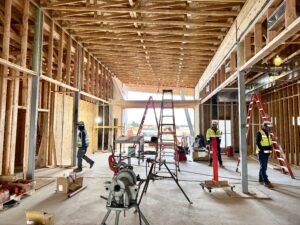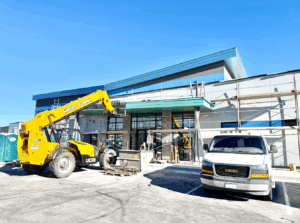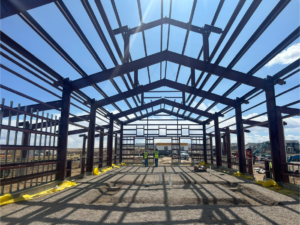Trends in Adventure Playground Design
Adventure playgrounds are evolving, emphasizing natural elements and diverse play experiences to engage children and foster creativity. These playgrounds go beyond traditional swings and slides, offering versatile environments that encourage exploration, risk-taking, and physical activity. This article explores current trends in adventure playground design, the incorporation of natural features, optimal park sizing, perimeter safety considerations, and surfacing recommendations.

Incorporating Natural Features for Versatile Play
Modern adventure playgrounds focus on integrating natural features to create dynamic and versatile play environments. These elements provide children with opportunities to interact with nature and engage in imaginative play.
- Logs and Tree Stumps: Incorporating logs and tree stumps offers children a chance to balance, climb, and jump. These natural elements enhance motor skills and provide a tactile experience.
- Boulders and Rock Climbing Walls: Boulders and rock climbing walls challenge children to develop strength, coordination, and problem-solving skills. These features can be integrated into the landscape, blending seamlessly with the natural surroundings.
- Sand and Water Play Areas: Sand and water play areas encourage sensory exploration and creative play. These zones allow children to build, dig, and manipulate materials, fostering cognitive development.
- Natural Vegetation and Planting: Incorporating trees, shrubs, and grasses into the playground design creates shade, improves air quality, and offers habitats for wildlife. Natural vegetation also provides opportunities for nature-based learning and exploration.
- Hills and Mounds: Earth mounds and hills add verticality to the playground, offering varied perspectives and physical challenges. These features can be used for sliding, climbing, and rolling, promoting active play.
Optimal Park Size and Perimeter Safety Considerations
Designing the right-sized adventure playground depends on the community’s needs and the variety of features included. Safety and access are also crucial factors.
- Small Community Playgrounds: For small communities, an adventure playground of 5,000 to 10,000 square feet can accommodate essential features like logs, boulders, and sand play areas. This size allows for diverse play experiences while remaining manageable in terms of maintenance.
- Mid-Sized Playgrounds: A playground of 10,000 to 20,000 square feet offers space for more complex natural features, such as climbing walls, water play zones, and hills. This size is ideal for larger communities and public parks.
- Large Regional Playgrounds: Regional adventure playgrounds, ranging from 20,000 square feet or more, can include extensive natural landscapes, multiple play zones, and amenities like picnic areas and restrooms. These parks cater to a wide range of age groups and attract visitors from surrounding areas.
- Perimeter Area for Access and Safety: Surrounding the playground with a 10 to 15-foot perimeter buffer ensures safety and provides space for caregivers to supervise children. This area also allows for easy access and helps separate the play zones from nearby roads or other park activities.
Playground Surfacing Recommendations
Choosing the right surfacing material is critical for the safety and durability of adventure playgrounds. The surface must provide adequate fall protection, support natural play elements, and require minimal maintenance.
- Engineered Wood Fiber (EWF): EWF is a popular choice for adventure playgrounds due to its natural appearance, shock-absorbing properties, and ease of installation. It blends well with natural elements but requires regular top-ups and maintenance to maintain safety standards.
- Rubber Mulch: Rubber mulch offers excellent fall protection and requires less frequent maintenance than wood-based materials. It is available in various colors, but it may not blend as seamlessly with natural landscapes.
- Poured-in-Place Rubber: Poured-in-place rubber surfacing provides a smooth, durable, and low-maintenance option. It offers excellent accessibility for children with mobility challenges and can be customized with patterns or colors. However, it may be less aesthetically aligned with natural environments.
- Grass and Turf: Natural grass or artificial turf can be used in lower-impact areas, offering a soft surface that integrates well with natural elements. However, natural grass requires regular upkeep, while artificial turf can become hot in direct sunlight.
- Sand and Gravel: These materials offer a natural aesthetic and are ideal for sensory play zones. However, they may not provide sufficient fall protection for high-impact areas and require regular raking to maintain an even surface.
Conclusion
In conclusion, adventure playground design trends emphasize the integration of natural features to create versatile, engaging play environments. By incorporating elements like logs, boulders, sand, and vegetation, playgrounds can offer diverse play experiences that encourage creativity and physical activity. Optimal sizing, adequate perimeter space, and the right surfacing materials are essential for ensuring safety, accessibility, and low maintenance. As communities continue to value outdoor play, adventure playgrounds will play a key role in promoting children’s health and well-being. By embracing these trends, communities can create adventure playgrounds that not only meet the needs of today’s children but also provide lasting value for future generations.
References
- International Play Equipment Manufacturers Association (IPEMA). (2023). Playground Design and Safety Standards. Retrieved from IPEMA
- National Recreation and Park Association (NRPA). (2022). Trends in Public Park Design. Retrieved from NRPA
- Play England. (2021). Designing Natural Playgrounds. Retrieved from Play England
- American Society of Landscape Architects (ASLA). (2023). Adventure Playground Design Guidelines. Retrieved from ASLA










